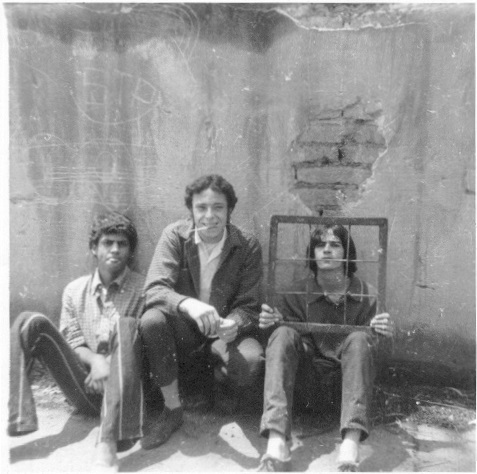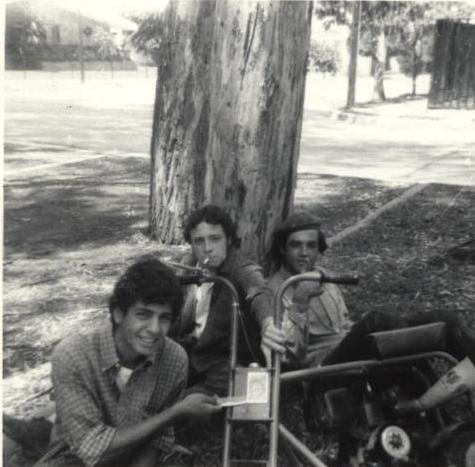by José Luis Mendoza
Part 1
I was 14 years old, and my friend from school, Pancho, and I stumbled upon a Kodak camera at a flea market. We got really excited and bought it right away. We rushed to find a place to buy some film so we could take some pictures; we were thrilled. We bought a roll of 12-exposure film, and the store clerk helped us load it into our newly acquired camera and explained how to use it. We dashed off to find our friends to take some photos.
There was a grove near our houses where we used to meet every afternoon. When we arrived, there were only about two or three other kids our age. We showed them our treasures and started planning a group photo. We decided who would take the photo, and the rest of us started striking poses that we thought would define who we were and what we thought at that important moment, a valuable document that would challenge time and remain eternally significant.
It took us the whole afternoon to take two group photos, and we were all excited. We went to bed full of anticipation. The next day, Pancho and I went to school in the morning, and in the afternoon, we grabbed our camera and embarked on a photo hunting adventure. We felt like reporters for a big magazine.
It took us three days to finish taking the remaining 10 photos. We rushed to get the film developed, and the clerk told us it would take 10 to 15 days because they had to send it to a specialized lab. Two weeks passed before we finally held the precious envelope with the negatives and black-and-white printed photos in our hands. We were overflowing with excitement and couldn't wait to see the results of our venture into the world of images. However, we decided to postpone that moment until we met up with the rest of the gang at the grove.

We arrived, and there were about eight other kids already gathered. We told them that we finally had the photos. Excitement spread, and everyone huddled around me, and then I... opened the envelope. We were all deeply moved. What excellent photos! We felt incredibly important. In reality, some of them turned out blurry because the photographer had moved, two were completely black (overexposed), and about six were good. We all admired them in silence, and then we started laughing with joy. Look at Javis, he looks so funny! Toño on his little homemade lawnmower motorcycle, and the Monkey with his long hair. What wonderful moments we had, and it had all happened in less than a month... And there were six marvelous photographs for posterity...
In these times, humanity faces an unprecedented phenomenon: abundance. In a world characterized by rapid technological advancement, globalization, and constant interconnectivity. We find ourselves immersed in an endless torrent of information, choices, and possibilities. This excess, instead of enriching us, can create a vertigo that impacts our mental health, decision-making abilities, and our perception of reality.
Abundance manifests itself in various aspects of our lives. From childhood, we are inundated with a barrage of stimuli from electronic devices, social media, and entertainment platforms. This constant exposure not only affects concentration and creativity but can also lead to addiction and social isolation. The need to always be connected deprives us of moments of reflection and contemplation, which are essential for personal development and a deeper understanding of our surroundings.
In the realm of information, the internet provides instant access to vast amounts of data and opinions. However, this indiscriminate access can lead to the spread of false or erroneous information, eroding trust in reliable sources. Furthermore, the excessive accumulation of data can make it difficult to identify what is truly relevant and valuable. The result is a sense of confusion and disorientation, where discerning the truth becomes a constant challenge.

Consumption is also affected by abundance. The proliferation of choices in all aspects of life, from food to electronic products, can lead to analysis paralysis. The relentless pursuit of the best option can result in chronic dissatisfaction, as choosing one thing implies giving up countless other possibilities. Consumer society thrives on this unease, creating an endless cycle of unfulfilled desires.
Abundance not only influences what we consume but also how we perceive our purpose and meaning in life. In a world where possibilities seem infinite, the pressure to make defining life choices can generate anxiety and fear of regret. Constant comparison with others, facilitated by social media, can fuel feelings of inadequacy and envy, undermining self-esteem and authenticity.
To counter the vertigo of abundance, it is imperative to cultivate mindfulness and discernment. Learning to disconnect at specific moments, practicing conscious selection of the information we consume, and focusing on what truly matters are fundamental steps. Additionally, we must recognize the importance of quality over quantity, both in our interpersonal relationships and in our consumption choices.
The characteristic abundance of the current era challenges us to find a balance between embracing new opportunities and establishing healthy boundaries. If we are not aware of the effects of excess in our lives, we risk being trapped in a whirlwind of options and stimuli that erode our mental health and our ability to fully enjoy life. Only through reflection, self-discipline, and a focus on the essential can we overcome the vertigo of abundance and find serenity in a constantly moving world.
I miss the time when life was slower; I had time to savor and marvel at the simple things, like the black-and-white photographs (which I still have), planned by curious and excited teenagers.